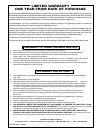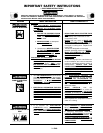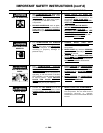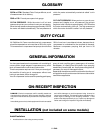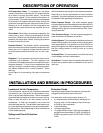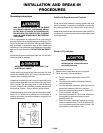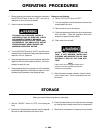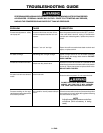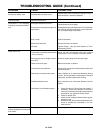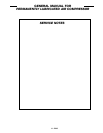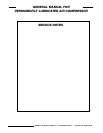
5 - ENG
GLOSSARY
which the motor automatically re-starts is called "cut-in
pressure."
CUT-OUT PRESSURE: When you turn on your air com-
pressor and it begins to run, air pressure in the air tank
begins to build. It builds to approximately 125 PSI before
the motor automatically shuts off .The high pressure at
which the motor shuts off is called "cut-out pressure."
SCFM or CFM: Standard Cubic Feet per Minute; a unit
of measurement of air delivery.
PSIG or PSI: Pounds per square inch gauge.
CUT-IN PRESSURE: While the motor is off, air tank
pressure drops as you continue to use your accessory.
When the tank pressure drops to approximately 100 PSI
the motor will restart automatically. The low pressure at
DUTY CYCLE
All DeVilbiss Air Power manufactured air compressors
should be operated on not more than a 50% duty cycle.
This means an air compressor that pumps air more than
50% of one hour is considered misuse, because the air
compressor is undersized for the required air demand.
Maximum compressor pumping time per hour is 30
minutes.
You have purchased an air compressor unit consisting of
a one cylinder, single-stage air compressor pump, an air
tank, and associated controls and instruments.
This air compressor requires no oil. Now you can enjoy all
the benefits of having an air compressor without ever
having to purchase, add or change oil.
Your air compressor can be used for operating paint spray
guns, air tools, caulking guns, grease guns, air brushes,
sandblaster, or inflating tires and plastic toys, spraying
weed killers, insecticides, etc. An air pressure regulator is
necessary for most of these applications.
Separate air transformers which combine the functions of
air regulation and/or moisture and dirt removal should be
used where applicable.
GENERAL INFORMATION
DAMAGE: Each air compressor outfit is carefully tested and
checked before shipment. With improper handling, damage
may result in transit and cause problems in compressor opera-
tion.
Immediately upon arrival, check equipment for both concealed
and visible damages to avoid expenses being incurred to
correct such problems. This should be done regardless of any
visible signs of damage to the shipping container. If this
product was shipped directly to you, report any damages to
carrier and arrange for inspection of goods immediately.
ON-RECEIPT INSPECTION
Install Isolators
1. Install isolators to feet using screws provided.
INSTALLATION (not included on some models)




